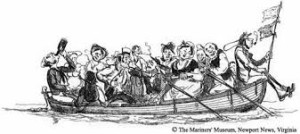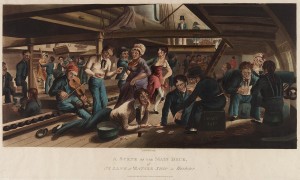Alexander Howison (b.1795): Habits, Culture & Beliefs
‘- the easy careless life of a sailor.’

As Alexander started work very early in his life (around 9 or 10 years old) recreational activity is not mentioned until he is aboard the ship the ‘Newcastle’ in 1813 when he is around 18 years old. Here the normal cultural recreational activity within the Merchant and Royal Navy is observed. For a sailor free time was obviously limited while at sea so the sailors must make their own entertainment. ‘The sailors seldom get liberty to go on shore’. However ‘merchants of all descriptions are admitted on board – to traffic in everything.’ (p.23)
Traditionally sailors drink, gamble and entertain prostitutes, these activities were linked to the culture of the Navy and being aboard man-of-war vessels. By Alexanders own admission he ‘never saw rum shipped without trying the quality’ (p.19) Up to the mid-1700’s sailors aboard British Navy vessels were issued with half a pint of rum per day.
‘During the American War the only money the sailor had to sport was his prize money (p.27) This was known as Halifax Harvest and when in this port during war was where the sailors were paid for their services. All other money was made from gambling between the sailors,

Alexander also describes the ‘bumboats’ or ‘jolly boats’ (Women and the Sea) being loaded with women at the shore and brought aboard. The women then pretended to be the sailors ‘sisters’, staying with the sailors till they left port.
Prostitution as a recreational en devour for sailors ensured that ‘even the unmarried seamen are provided for if they choose’ (p.23) ‘Watermen carry out boatloads of females to the ship, and if a first-rate cargo, they are generally disposed of at very remunerative prices, 5/- a head for the prettiest.’ It is clear that deals were done often and prices varied because once the women were on board it was time and money lost to take them back to shore if a deal was refused.It is noted that ‘the most general charge is for ordinary ladies 2/6.’ ‘Prostitution was a fixture in every port town. A thriving business, it symbolized not only the rootlessness of the sailor’s life, but also the financial desperation many women experienced when their men went off to sea for long periods.’ (Women and the Sea) As a means to an ends this was the best way for women to make some extra money when their men were away at sea as no income was given to the wives and no word of their return to shore together with the possibility that the men would be lost at sea pushed the need to become prostitutes.

The Mariners’ Museum
As entertainment had to be made on their own terms, card games and the exchange of money was common for the time. ‘People lost no opportunity in placing wagers on the outcome of undecided events, turning the minutiae of daily life into tense gambling situations.’ (Reith p.63) ‘there is nothing however trivial or ridiculous, which is not capable of producing a bet’ (Hibbert p.372)
Alexander acknowledges that the recreational habits of the sailors are not entirely honorable or within religious perimeters. ‘My readers can now contrast the difference between a ship of war and the Established Church.’ (p.24)
Works Cited:
Hibbert, C. The English. London: Grafton Press. 1987.
Howison. Alexander. (n.d) Autobiography of Alexander Howison ‘Burnett Archive of Working-Class Autobiography, University of Brunel Library. 1:354
‘Women and the Sea’. marinersmuseum.org. N.d. Web. Accessed 15 December 2014.
Reith, Gerda. The Age of Chance: Gambling in Western Culture. Routledge, 2005.
Image A:
Image B: ‘Women and the Sea’. marinersmuseum.org.
Image C: ‘Women and the Sea’. marinersmuseum.org.

Leave a Reply